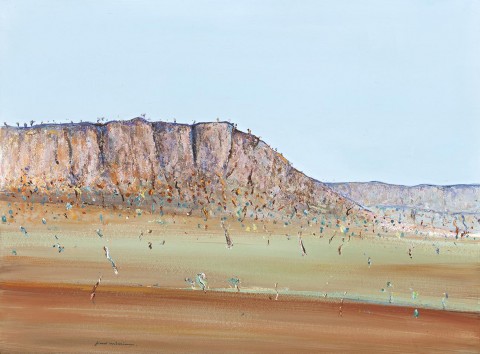KARRATHA STATION, c.1979 - 81
FRED WILLIAMS
gouache on paper
58.0 x 76.5 cm
signed lower left: Fred Williams
Private collection, Melbourne
Art Equity, Sydney
Private collection, Malaysia
Accompanied by a certificate of authenticity, Rex Irwin Art Dealer, Sydney, signed and dated 29 July 2010.
In 1979, Fred Williams was invited by the chairman of the mining company CRA (now known as Rio Tinto), Sir Roderick Carnegie, to visit the Pilbara region in Australia’s remote north-west. Carnegie, a family friend of the Williams, had been impressed by the artist’s recent aerial paintings of mining operations at Weipa in Queensland and invited him to compare this experience with the awe-inspiring scale and raw elemental power of the Pilbara. Based on visual material gathered during two consecutive trips, Williams produced a remarkable body of work, twelve landscape paintings and a large number of gouaches. These Pilbara paintings were to become his last series – twelve months after their completion, in April 1982, the artist passed away.
Patrick McCaughey, in his monograph on Fred Williams, explained that while CRA made no formal commission for the creation of these landscape paintings, there was ‘a vague idea that he [Williams] should record the Pilbara before it was changed by the effects of mining’.1 CRA had been operating mines in the region for a little over ten years, and the town of Karratha was still young. Flying over the region in a biplane and taking hundreds of photographs, Williams desperately sought to capture the nuances of this foreign landscape, then using the fast-drying medium of gouache to faithfully and immediately transcribe its saturated minerally rich colours. Gouache enabled the creation of a wider range of textures, from thick daubs to wide washes, handled with fluidity and apparent impetuousness.
Karratha Station, c.1979 – 81 is one of the gouaches painted either in situ or in a flurry of activity immediately upon the artist’s return to Melbourne. Williams was so impatient to fix the images onto paper that it was only in March of 1981 that he returned to the subject to execute a final series of landscapes in oil – all of these paintings were eventually acquired by CRA (and subsequently donated to the National Gallery of Victoria, Melbourne) along with eighteen of the gouaches, many others being purchased by the National Gallery of Australia.
The lands that form the Pilbara region are ancient and rich with minerals. Residing at Karratha Station, a country property fifteen kilometres from the coast, Williams surveyed the rugged outline of the Hamersley Range enclosing the echoing empty landscape. He studied the nuances of this strange landscape and became fluent in their expression in paint. Karratha Station incorporates many of the most dramatic features of this other-worldly outback landscape, trees dwarfed by rugged red cliffs, a low horizon buckling under an enormous expanse of blue sky, seams of bright mineral deposits segmenting the landscape into successive layers, interspersed with fields of spinifex and wildflowers. Remarkably detailed and naturalistic while retaining the distinctive Williams brushstroke, Karratha Station is characterised by touches of paint and lines laden with pigment set against a sweeping wash, its delicate tones evoking the overwhelming vastness of the artist’s vista of this timeless and enduring landscape.
1. McCaughey, P., Fred Williams 1927 – 1982, revised edition, 1996, Murdoch Books, Sydney, p. 321
LUCIE REEVES-SMITH
